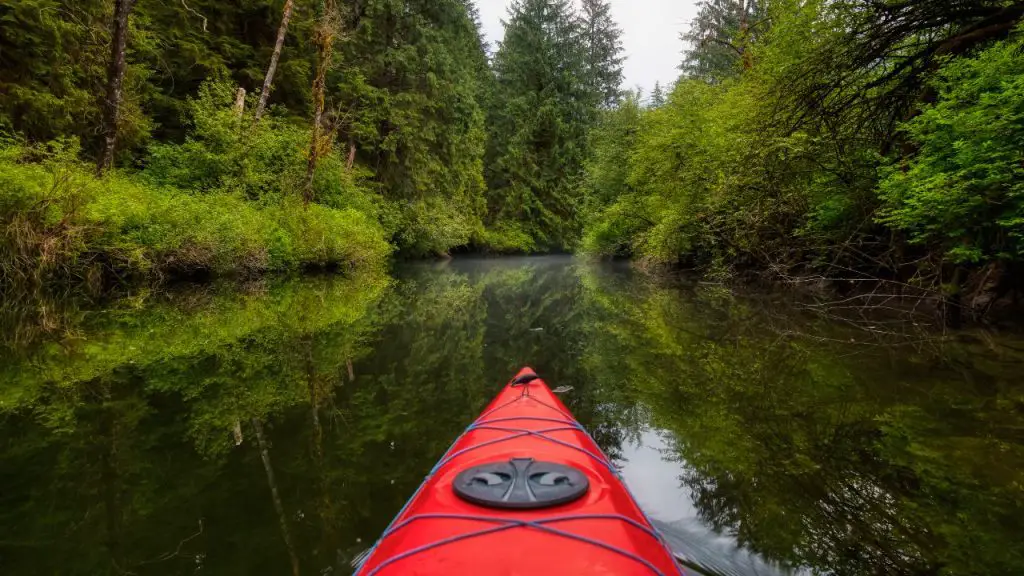Anchoring is a great way to prevent your kayak from drifting downstream when you are fishing in a river. The process can be tricky, especially in a river with strong currents. To anchor a kayak in a river, you have to choose the right anchor and cast it appropriately.
You can use stakeout poles, an outrigger kit or drift sock to keep your kayak in one place, but in some cases, you will just need an anchor. That’s why anyone interested in kayak fishing should learn how to use anchors appropriately.
In this post, we are going to offer some tips and tricks that you may find useful. Here you will also find some other frequently asked questions about using anchors.
Table of Contents
3 Steps To Anchor a Kayak in a River
In order to anchor your kayak in a river, choose an anchor based on factors such as the current of the river and the type of riverbed. Also, choose the anchor line carefully—it must be appropriate to the anchor type.
The anchor line has to be attached to cleats, so you will have to install them in your kayak. The actual process of anchoring a kayak is pretty straightforward: just drop the anchor into the water and keep releasing the anchor line as long as the anchor drags. Secure the rope in the boat once it has stopped moving.

Choose Right Anchor and Line
The anchor you choose should be reasonably heavy, so that it can keep the boat in place. But do not choose an excessively heavy anchor—it will add too much weight to your kayak.
A folding grapnel anchor anchor is the best option for a soft or sandy bottom. If you are fishing in a shallow river with a muddy or sandy bottom, consider using a stakeout pole.
For larger watercrafts, the ideal length of an anchor line is 7:1. That means, 7 feet of anchor rope is needed for each foot of depth.
Securely Attaching The Anchor Line To The Kayak
Every kayaker should master the art of anchoring a kayak. Here are some step-by-step instructions:
- Step 1: First, drop the anchor into the water and then clip the anchor line through the anchor trolley carabiner.
- Step 2: Keep letting the anchor line out even after the anchor has reached the riverbed. Stop when the length of the released line is about twice the depth so that the anchor finds a good angle. Release more line if your anchor keeps dragging. Secure the line once the kayak has stopped moving.
- Step 3: Tie the anchor line to a cleat. A plastic cleat, preferably a jam cleat is great for a quick and smooth release.
Anchor Into The Soil
To some extent, the difficulty of anchoring a kayak in a river depends on the riverbed. If it is composed of mud or sand, a fluke anchor will get stuck relatively easily. Once your kayak has stopped moving, secure the line to the cleat.
Tie the line in a way that allows you to release it smoothly and quickly. A jam cleat is good for a quick-release, low-profile connection. You will not have to use knots to secure the rope, or worry about the cleat getting loose.
Where Should You Mount an Anchor on a Kayak?
In general, you should mount an anchor from the stern or bow of your kayak. Never anchor a kayak from a side because it will increase the risk of flipping when there are strong currents or winds.
Consider investing in an anchor trolley. It will enable you to switch the anchor from one end of your kayak to the other—without having to recast the anchor. If you are using an anchor trolley, you may be tempted to anchor from the side. Resist that temptation!
Extreme Max 3006.6548 Boat
FAQs
How to anchor a kayak without a trolley?
A trolley is not necessary for anchoring a kayak. For this, you may need to install multiple cleats. Also, consider using a gripper or pole to prevent your kayak from moving.
How heavy of an anchor do I need for a kayak?
The size of an anchor is more important than its weight. In general, kayak anchors weigh 1.5lbs to 3.5 lbs. For calm waters, a 1.5 lb anchor is perfect.
If the winds or currents are strong, or if you are using a relatively heavy kayak, use a 3 or 3.5 lb anchor. When deciding on the weight of the kayak, the overall load on the kayak should also be taken into consideration.
What’s the best way to anchor a kayak?
Do not use an unnecessarily large or heavy anchor. A grapnel anchor works pretty well in most cases. In shallow water, consider using a stakeout pole to secure your kayak quickly and easily.
Do I need an anchor for my kayak?
An anchor prevents your kayak from drifting when you are fishing in a river or lake. That means, an anchor can make kayak fishing easier and more enjoyable. By anchoring your kayak in your favorite spot, you can just focus on fishing.
Final Words
You are not an experienced kayaker until you know how to anchor your kayak. With the right equipment and a little bit of strategy on your part, it’s not that hard to anchor a kayak in a river. Kayak fishing in a river does not have to be a hassle.
And once you have mastered the art of anchoring your kayak, you will enjoy kayak fishing even more. We hope now you are better prepared to make informed decisions.

